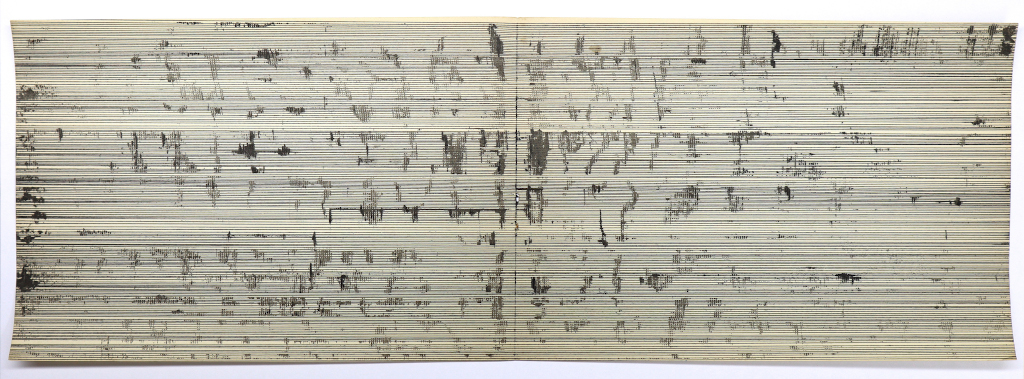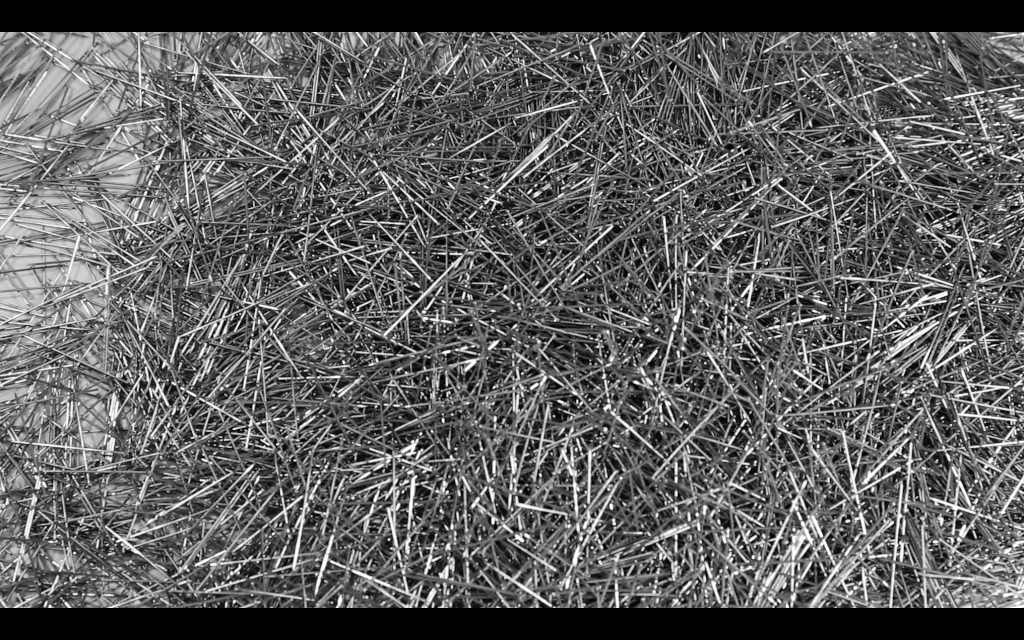An interview by Selin Tamtekin with artist Defne Tesal regarding her upcoming exhibition ‘Hesitation’ at Pilevneli Dopladere Gallery, Istanbul

Defne Tesal and site-specific installation Hesitation, installation shot PILEVNELI Dolapdere.
Our interview takes place in late summer. I arrive at the artist’s studio in the afternoon of the hottest day of my stay in Istanbul. Defne Tesal’s studio is in a quiet residential street on the Asian side. Overlooking a leafy back garden and shaded by tall trees, it’s a cool relief from the oppressive heat I‘ve been enduring.
“Hesitation is a breathing space before you make a decision”
Before Tesal shows me works, she talks me through the theme of her exhibition:
“Hesitation is a word which at first has a negative connotation” she acknowledges, adding “but actually, it’s a breathing space before you make a decision. That shouldn’t be such a bad place to be. If I can linger there for a bit longer and stretch that time… It’s a moment of pause, nothing is moving forward; at the same time everything is in motion, restless, wriggling – back and forth. I wanted to explore the movements and emotional states of that moment.”
“Does your approach have a meditative angle?” I query.
Like her artwork, Tesal’s demeanour is serene and contemplative. She ponders before she answers: “Yes, I believe it does. Generally, I wish my pieces to evoke the internal rhythm we are unable to capture in our daily lives. That’s why I like to create works that are calm, fluid and rhythmic.”

“They will be in a constant state of motion – wriggling”
Tesal brings a loose bundle of cotton yarn out of a plastic bag. I briefly touch and feel its raw texture between my fingers. She tells me she plans to construct a site-specific installation with this material – it will cover a wide area on Pilevneli’s top floor.
Multiple vertical yarns will hang from the ceiling, their ends fastened onto the floor. With soft air emitted from above through noiseless fans, they will be gently swaying.
Tesal says: “The strings will not be going anywhere; at the same time, they will be in a state of constant motion – wriggling.”
Next, she withdraws a folder to show me some examples from a series of small landscapes that will be displayed frameless.
The subject of landscape has been a long-time interest for the artist. In 2013, she executed a series of landscapes in cotton yarn sown onto fabric, where the sky, sea and hills had been reduced to segments in earthy tones.
Her more recent landscape series is on gridded and lined paper. Complying with their rigid layouts, using a metal ruler the artist draws many lines over the paper with an ink pen. Inevitably smudges occur and create patterns – landscapes – of their own.
Tesal remarks, “When the materials I collaborate with surprise me and demonstrate that I’m not as much in control as I believe to be – this is something I really sought after.”

Defne Tesal, Imperfections turning into Landscapes -16, 2021, 49x17cm, ink on lined paper. Courtesy of PILEVNELI
“How can I reclaim time as an artist?”
Moved by the commitment Tesal possess towards her clear artistic vision, I slowly flick through the individual works in the folder while imagining her at work – absorbed in the repetitive act.
“I have been occupied with the concept of ‘time’ for a while. I’ve kept thinking of how I can reclaim time. Then I came across this book. It helped me better identify my feelings,” the artist explains.
The book Tesal cites as a strong influence to her work is Byung-Chul Han’s The Scent of Time: A philosophical Essay on the Art of Lingering.
In it, at one point Han argues: “Being cannot be reduced to being active. Even acting itself must contain moments of pausing in order not to freeze into mere labour (…) What distinguishes acting from labouring is not a surplus of activity, but the capacity to pause. Whoever does not know how to hesitate is a labourer.” *
I think it’s a paragraph everyone should refer to and consider, once in a while.
When I ask Tesal what she exactly means by ‘wanting to reclaim time,’ she replies:
“In this age, especially in urban life, ‘time’ has become a device that controls you. Instead of our internal clocks and our own rhythms we abide by collective routines. For me this raises the question, how can I reclaim time as an artist while leading such a life?”
She then responds: “By doing acts that don’t necessarily lead to a result. By repeating the same act, like dropping pins. Pins are actually for attaching things together but what if they were to just fall and we were to just watch this happen?”

Defne Tesal, Falling Pins, 2018, duration: 6’52”, video, screen shot. Courtesy of PILEVNELI
“After a while they start to do their own choreography”
Tesal is referring to one of her three video pieces from the Falling Series that will be playing in a loop on separate screens. In Falling Pins, Falling Strings and Falling Chickpeas the artist has captured metal pins, a long thread of cotton string and dry chickpeas in the act of falling until they cover the entire surface area. Tesal shows me short clips of these rather straightforward videos that she has not manipulated in any way. I eventually get to watch them in full after returning to London. It’s then I notice: even though the particles are falling at the same speed, in each video, from time to time one’s eye is tricked into the illusion of acceleration and deceleration and of sporadic movement.
While viewing the short clips from these videos together back at her studio, the artist remarks, “After a while, it’s as if, they start to do their own choreography and move me from the position of the enabler to the position of the onlooker.”

“A lot of my work is a study in concentration”
Reflection, Haze and Ice – parts of another work on paper series which will be on exhibit, are finely detailed, entrancing large-scale abstractions. In each one, Tesal has methodically kept applying identical strokes with transparent markers in varying soft hues.
“A lot of my work is a study in concentration,” the artist recognizes.
Altogether these restrained strokes resemble the crisscross texture of the raw cotton she uses in her embroidery. As some of these subtle marks lap over each other, layers evolve in certain areas, like overlapping stitches, that on occasional glance, like in her Falling Series, trick one’s eye – this time, into the illusion of movement. The states these works represent, namely ‘reflection’, ‘haze’ and ‘ice’ also correlate to the in-between phases of ‘hesitation.’

Master Acts without Doing Anything
Lastly, the artist brings out a piece of folded fabric. When she holds the large work up from the sides, I’m able to recognize the image of an ultramarine blue rock in the making – at that stage she is halfway through embroidering the piece. Tesal reveals to me where she got her inspiration from:
“A few months ago, I came across these beautiful rocks on the Aegean coast. They appeared so stable but actually, they’re also in a constant state of change.”
The connection between Blue Rock and another piece intended for the exhibition, Master Acts without Doing Anything, is evident.
Tesal has filmed a solitary tree, using a hand-held camera, for the duration of eighteen minutes.
“I stopped filming when I lost my focus, which happened when I reached the eighteenth minute,” she discloses.
The silent video piece will be granted its own dark room with a bench where people can sit and watch, and hopefully absorb and contemplate.

Defne Tesal, The Master Acts Without Doing Anything, duration: 18’04’’, video, screen shot. Courtesy of PILEVNELI.
At several points we see birds fly off and onto its branches. But otherwise, nothing much happens in this video. On the other hand, too much is happening all at once: with the light breeze in the air the lush leafy branches of the majestic tree sway both together and independently of one another – like a symphony performing its own intrinsic rhapsody.
“That tree is so complete and effortless. All I want to do is just observe it. Hierarchically it’s above the rest of the pieces in the exhibition – it signifies the point I would like to reach,” says Tesal.
I tell the artist how when I’m observing trees, with their self-assured, silent postures and longer lifespans, I sometimes imagine them carrying more wisdom than us and possibly having a greater understanding of the existence of things.
“This contemplation often brings about a sense of inner peace, which I also experienced while watching your video,” I state.
Tesal smiles and replies:
“In a way we are projecting ourselves by assuming it’s giving us the emotion we are after but are unable to produce at that point. But this indicates, those feelings are not too remote from us – it’s a thought which gives me hope.”
This article was first published in Turkish on the website T24
Defne Tesal, Hesitance will be running from 27 October – 05 December 2021 at Pilevneli Dolapdere in Istanbul.
*Han, Byung-Chul The Scent of Time: A philosophical Essay on the Art of Lingering, trans. Daniel Steuer (Cambridge and Massachusetts: Polity Press, 2017) p. 105.

